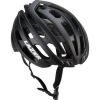Because of my work on the best road bike helmets buyers guide, I look at a lot of helmets. As that volume of options passes through my hands, one of the things that’s obvious is how stratified modern road bike helmets are. Unlike the UCI’s limit on bike weight, there’s no lower weight limit for helmets and each brand is welcome to innovate in whatever way makes sense. At the top of the range, some go for aero, others go for lightweight ventilation.
Price: £229.99 / $279.99 / €249,99
Available colours: White, Matte Black, Cosmic Blue, Harbor Grey, Metallic Red, Flash Orange
Rotational Impact technology: Kineticore
Weight: 226g as measured in size S
In this case, the Lazer Z1 helmet is the brand’s premier climber’s helmet. It sits alongside the aero focused Vento Kineticore in the lineup but so far the Vento has had something the Z1 hasn’t. Even though the Vento has been out since 2022, and we’ve seen a number of lower spec Lazer helmets get it, only now is the Z1 getting the Kineticore treatment. Kineticore isn’t the only change though and the latest Z1 is coming to market as one of the lightest, if not the lightest, road bike helmets available.
If your preference for helmets is light and airy, the Z1 might be just what you are looking for. Keep reading to see my experience with the Z1 and decide if it’s time for a new lightweight helmet for your summer, or even winter, riding.
Design and aesthetics
As I worked on the news article covering the launch of this new helmet, I spent a considerable amount of time trying to figure out what is new and what is not. The most obvious difference is on the inside of the new Lazer Z1 Kineticore. It’s there where things start with a switch away from the well-known MIPS rotational impact technology to Lazer’s own proprietary Kineticore system.
While modern MIPS technologies have come a long way, the Lazer Z1 MIPS was new back in 2020. The MIPS the helmet was using came from a time when MIPS meant a layer between the hard foam and the padding that covered the entire helmet. Although the end result of creating a slip plane that allows a helmet to shift around your head in a crash hasn’t changed, the older style wasn’t universally loved. Some people didn’t notice it much but others rightly pointed out that it made helmets hold heat…
Click Here to Read the Full Original Article at CyclingNews RSS Feed…

